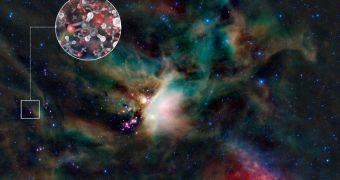A simple form of sugar called glycolaldehyde was recently identified in massive gas clouds surrounding a newly-born star. The Sun-like object is called IRAS 16293-2422, and it’s the first star known to harbor sugar molecules so close to its surface.
Finding chemicals such as glycolaldehyde in space is nothing new. However, astronomers only manage to discover it in deep space until now, relatively far away from massive heat sources. But there is a much more significant implication associated with the new study.
What discovering sugar at this location shows is that molecules essential for the development of life can be found at the correct time/position to be included in the protoplanets, asteroids and comets whose formation usually accompany the formation of a new star.
The material originally in molecular clouds – that does not fall into the star itself – normally begins to spin around the new cosmic fireball, in a structure called the protoplanetary disk. Within this ring, the seeds that will eventually turn into the aforementioned objects begin to form.
Since sugar is present in the debris field around new stars, it's safe to say that it will be incorporated into these objects as they form. This implies that any planet developing in the IRAS 16293-2422 will feature sugar molecules, which are critical components for all known lifeforms.
“In the disc of gas and dust surrounding this newly formed star, we found glycolaldehyde, which is a simple form of sugar, not much different to the sugar we put in coffee,” Jes Jørgensen explains.
“This molecule is one of the ingredients in the formation of RNA, which – like DNA, to which it is related – is one of the building blocks of life,” adds the expert, who is the lead author of the new study. The astronomer is based at the Niels Bohr Institute, in Denmark.
The team of researchers he led used the Atacama Large Millimeter/submillimeter Array (ALMA), in Chile, to conduct the investigation. ALMA is still far from completion, but experts say that it will be the most complex and capable radio observatory ever.
“What it is really exciting about our findings is that the ALMA observations reveal that the sugar molecules are falling in towards one of the stars of the system,” Aarhus University astronomer and study team member, Cécile Favre, says.
“The sugar molecules are not only in the right place to find their way onto a planet, but they are also going in the right direction,” the expert adds. Details of the new study will appear in an upcoming issue of the esteemed Astrophysical Journal Letters.
ALMA is supported by the European Southern Observatory, the US National Science Foundation, the National Research Council of Canada, the National Science Council of Taiwan, the National Institutes of Natural Sciences (NINS) of Japan, and the Academia Sinica in Taiwan.

 14 DAY TRIAL //
14 DAY TRIAL //